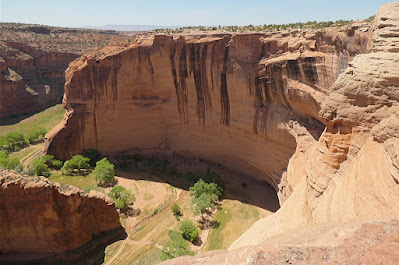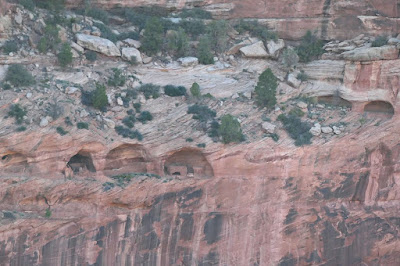On May 7th our Off the Beaten Path group departed Farmington, New Mexico, and headed for Chinle, Arizona, and the Canyon de Chelly. Driving west, we paused for a good look at Shiprock. This photo emphasizes how it dominates the horizon, rising over 1500 feet above the high-desert plain. (Click on any image to enlarge.)
I set my camera to max zoom for this image.After gawking for a while, we continued on. The flat plain gave way to switchbacks as we ascended to Buffalo Pass.The paved road is relatively recent - 1999.It's a kick-off point for various trails, but subject to the rules of the Navajo Nation.The altitude and a breeze made for a chilly stop despite the sunshine.You can tell which way the wind most often blows.The view towards where we'd come from was impressive. The little arrow I added points to Shiprock (click on the image to enlarge.)
Again, the camera at max zoom.After a thrilling descent down the far side, we passed through the Lukachukai community (our guide John named his dog Lukachukai) and stopped at some of the first overlooks down into the extensive Canyon de Chelly system.Ancient structures were tucked into sheltering alcoves.
Navajo still live and work on the green floor of the canyon.After the long drive, it was time for lunch at the Junction Restaurant in Chinle. Afterward, we stopped at the official Visitor Center for the National Monument. Of course, we checked out the park store. Then one of the rangers, a Navajo woman, treated us to a tour of the on-site hogan, the primary traditional dwelling of the Navajo. (No photos.) This was a special treat; it pays to be a small group with a guide who "knows the ropes!"
Our next stop was at the Antelope House Overlook.
There were warning signs at the edge, of course.A closeup of the one on the right ...It was flatly impossible to get all of the canyon into one sweep of my camera.Here's a more detailed view, emphasizing the work of eons of water flow: a flat, farmable/grazeable bottom defined by towering vertical cliffs.A look in the upstream direction.Millions of years of uplift and stream cutting reveal the pancake-thin layers of sandstone.
Adding color was this blooming cactus.
A detailed look at the geology of Canyon de Chelly is here.
We delayed dinner to experience the Spider Rock in the late afternoon. This sandstone spire rises 750 feet from the canyon floor, and according to Navajo tradition the taller spire is the home of Spider Grandmother.
Zooming in,A broad viewing platform has been built,allowing inspection of all the arms at this junction between Canyon de Chelly and Monument Canyon.Structures were visible along a far wall.
There was so much to observe. As the sun grew lower, the shadows began to climb up the spire. If you click on this image to enlarge, you'll see a black spot with wings to the right of the spire, crossing in front of the sandstone pile near the shadow's border.It's a raven. As the evening drew closer more ravens arrived, cawing to each other, swirling, and performing aerobatic maneuvers. As we walked back in the late dusk to the parking lot, they gathered into a mass and flew away. Roosting time, no doubt.
It had been a packed day. Now we looked forward to tomorrow with great anticipation: a four-wheeler drive up the canyon floor with a Navajo driver/guide. There's a lot to see.


























No comments:
Post a Comment
Comments may not appear immediately as they are moderated by the author to eliminate spam. Please, no commercial links!